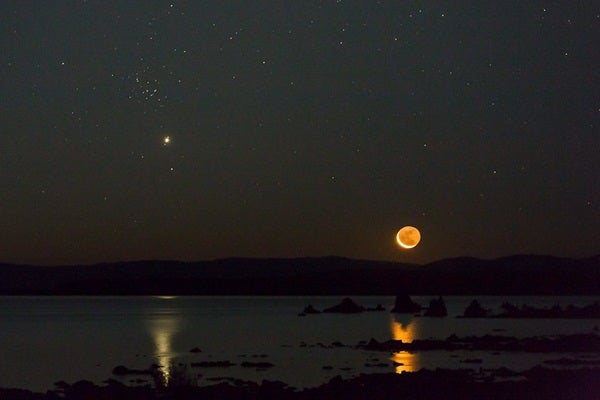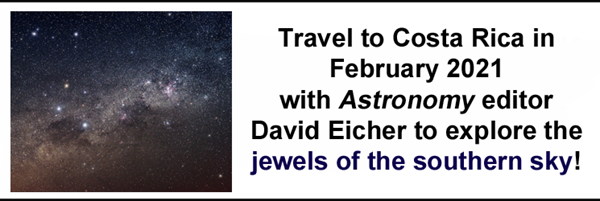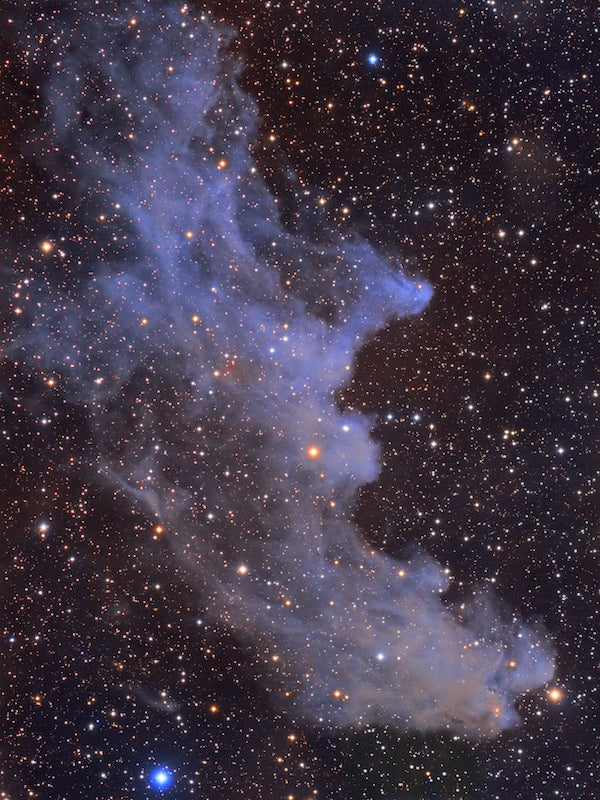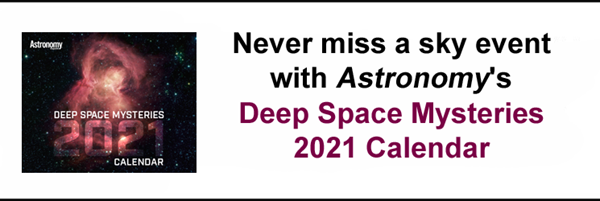Shortly after sunset, you can observe the two largest planets in the solar system — Jupiter and Saturn — glowing between the Teapot of Sagittarius and the stars of Capricornus in the southwest. The crescent Moon is nearby, shining near the center of the Sea Goat.
First, turn your telescope to Saturn to see its largest moon, 8th-magnitude Titan, about 1′ due north of the planet this evening. Much nearer the rings are Tethys, Mimas, and Enceladus, with Rhea and Dione a little farther away. These smaller moons are dimmer — magnitude 10 to 13 — and might require larger apertures to easily pick out.
Less than 3.5° west of Saturn, the Jupiter system is on full display tonight — Ganymede (farthest out) and Europa sit to the planet’s east, while Io and Callisto (farthest out) are to the west. This beautiful symmetry is brought to us partly by the fact that Jupiter’s equator is inclined just 3° to the ecliptic, giving Earth a nearly perfect edge-on view. Although the moons will stay on their respective sides of the planet this evening, consider tracking them over the next few hours to see if you can spot their movements — Io’s motion is most obvious, while the others may appear to barely budge.
Sunrise*: 6:51 P.M.
Sunset: 4:40 P.M.
Moonrise: 12:19 P.M.
Moonset: 10:11 P.M.
Moon Phase: Waxing crescent (36%)
*Times for sunrise, sunset, moonrise, and moonset are given in local time from 40° N 90° W. The Moon’s illumination is given at 12 P.M. local time from the same location.
Saturday, November 21
For those close to the equator or in the Southern Hemisphere, the Alpha (α) Monocerotids peak early this morning, with the best views between 1 and 3 A.M. local time, after the Moon has set. The shower’s radiant is close to the bright star Procyon in Canis Minor. This year, the shower’s expected maximum rate is just a few more than the sporadic rate of roughly seven meteors per hour. Still, if the skies are clear and the weather is comfortable, it’s worth venturing outside to monitor the skies for shooting stars. The Alpha Monocerotids are fast-moving meteors, zipping through our atmosphere at about 40 miles (65 kilometers) per second.
Located about 9.5° west-southwest of Alsciaukat, this cluster glows around magnitude 10. That makes it a bit of a challenge with binoculars and small scopes, but certainly possible under good conditions. Scopes larger than six inches will bring it out more readily.
First Quarter Moon occurs tonight at 11:45 P.M. EST.
Sunrise: 6:53 A.M.
Sunset: 4:39 P.M.
Moonrise: 12:54 P.M.
Moonset: 11:15 P.M.
Moon Phase: Waxing crescent (46%)
While a half-illuminated Moon floats in Aquarius, turn your gaze south late this evening to find another watery constellation: Eridanus the River. This southern constellation never fully breaches the horizon for many Northern Hemisphere observers, but is highest tonight at roughly 10:30 P.M. local time. One of the largest constellations in the sky, Eridanus winds its way from near Orion and Lepus down past Fornax and below the equator to end near Horologium and Phoenix.
One of the most famous deep-sky objects hiding in this constellation is IC 2118, also called the Witch Head Nebula. This faint reflection nebula sits less than 3° west of Rigel in Orion; the two are associated in three-dimensional space as well, as reflected light from this bright star causes the nebula’s glow. This faint cloud of interstellar dust is difficult to see even through a telescope, but astroimagers can bring out its subtle detail with longer exposures. If you want to test your photo processing skills or observing site’s dark-sky conditions, this is the target for you.
Sunrise: 6:54 A.M.
Sunset: 4:38 P.M.
Moonrise: 1:24 P.M.
Moonset: —
Moon Phase: Waxing gibbous (56%)
Monday, November 23
The Moon passes 5° south of Neptune at 7 A.M. EST, but both are below the horizon at the time. Instead, you can catch the pair after sunset, when they are just over 6° apart in the constellation Aquarius.
Neptune, whose dim magnitude 8 glow will require binoculars or a small scope, presents a bluish disk just 2″ across. It currently sits less than 1° east of magnitude 4.2 Phi (φ) Aquarii. Neptune is now roughly 30 astronomical units from Earth, where 1 astronomical unit, or AU, is the average Earth-Sun distance. That means its light takes a little over four hours to reach us here on Earth. Neptune has been slowly sliding southwest against the background stars, but in just a few days it will reach its stationary point and about-face to begin tracking northeast.
Sunrise: 6:55 A.M.
Sunset: 4:38 P.M.
Moonrise: 1:50 P.M.
Moonset: 12:17 A.M.
Moon Phase: Waxing gibbous (65%)
Tuesday, November 24
Starting an hour before sunrise, both Mercury and Venus should be easy to spot in the brightening sky. Mercury, just rising among the stars of Libra, is an easy magnitude –0.7. Venus is impossible to miss at magnitude –4. It’s sitting less than 2° from magnitude 4 Kappa (κ) Virginis and is now 10° due east of bright Spica.
Through a telescope, Mercury appears 90 percent illuminated and 5″ across. It is just 0.5° from Nu (ν) Librae, whose dim, magnitude 5 glow will fade quickly as dawn approaches. Venus is a much larger 12″ across, with a disk that’s 87 percent lit.
See how long you can follow the planets into the morning sky, but take care — stop using any optical equipment, including binoculars, at least several minutes before sunrise to avoid accidentally damaging your eyes.
Sunrise: 6:56 A.M.
Sunset: 4:37 P.M.
Moonrise: 2:13 P.M.
Moonset: 1:17 A.M.
Moon Phase: Waxing gibbous (74%)
Wednesday, November 25
The Moon passes 5° south of Mars at 3 P.M. EST. By sunset, our satellite is just 5.2° from the Red Planet. Mars remains in Pisces the Fish, while the Moon is south-southwest of the planet, just over the border in Cetus the Whale.
Let full darkness fall, then swing your scope to Mars to observe its 15″-wide disk, which shines at magnitude –1.3. Around 8 P.M. EST, the bright spot of Olympus Mons is visible on the disk; it will rotate out of view over the next two hours or so. The dark swaths of first Mare Sirenum, and later Mare Cimmerium, are also visible south of Olympus Mons.
NASA’s Mars 2020 mission is now less than 100 days from its landing on Mars. Recently, mission scientists released audio recorded by the Perseverance rover’s microphones as it travels through deep space. The sound is generated by mechanical vibrations that the microphone’s equipment has turned into an electrical signal. The soft buzz comes from the rover’s heat rejection fluid pump, which maintains the equipment’s temperature even in frigid cold.
Sunset: 4:37 P.M.
Moonrise: 2:36 P.M.
Moonset: 2:15 A.M.
Moon Phase: Waxing gibbous (82%)
The Moon reaches the farthest point from Earth in its orbit around our planet, called apogee, at 7:29 P.M. EST. At that time, our satellite will sit 252,211 miles (405,894 km) from Earth.
With our satellite visible all evening, it’s a great time to explore its pockmarked face. You’ll find the Moon in the southeastern corner of Pisces the Fish, now nearly 13° east of Mars. As the Moon travels around Earth, it can look to observers on Earth as if it’s “nodding” back and forth — sometimes areas at the limb are easier to see than others. This motion is called libration and tonight, it makes features normally hard to spot on the Moon’s northeastern limb more accessible. With binoculars or a small scope, look at the upper right portion of the lunar disk for three dark spots. These are Lacus Spei, Endymion, and Mare Humboldtianum (closest to the edge).
Come back over the next few nights, and you’ll see Humboldtianum slowly disappear in the last days of the month. By the 30th, Lacus Spei and Endymion will appear at the very edge of the disk.
Sunrise: 6:58 A.M.
Sunset: 4:36 P.M.
Moonrise: 2:59 P.M.
Moonset: 3:14 A.M.
Moon Phase: Waxing gibbous (88%)
Friday, November 27
Since last night, the Moon has crossed out of Pisces and traveled through the corner of Cetus, where it passed 3° south of Uranus at noon EST. By sunset in the Midwest, our satellite is now in Aries, about 4.5° southeast of the ice giant.
Uranus, currently magnitude 5.7, is visible in binoculars but may be hard to spot against our satellite’s glare. Just over 14° north-northwest of the Moon is Hamal, the Ram’s brightest star; 9.5° southeast is Menkar in Cetus the Whale. Look east-northeast of the Moon to find the Pleiades (M45); how many stars can you see without optical aid? Most observers can easily see five, but seven are visible for those with sharp eyes or dark skies. For the latter, you’ll need to wait a few more nights to give the Moon time to move away from the region. Some experienced naked-eye observers have seen 10 or more stars in this open cluster under the right conditions.
Sunrise: 6:59 A.M.
Sunset: 4:36 P.M.
Moonrise: 3:24 P.M.
Moonset: 4:12 A.M.
Moon Phase: Waxing gibbous (94%)













